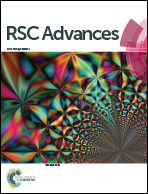Highly selective and sensitive detection of amaranth by using carbon dots-based nanosensor†
Abstract
In this work, a novel fluorescence nanosensor for selective and sensitive determination of amaranth was constructed using carbon dots (C-dots). Water soluble C-dots with strong fluorescence were obtained by a simple microwave-assisted method using urea and glycine as raw materials. It was found that amaranth can efficiently and sensitively quench the C-dots fluorescence by the inner filter effect (IFE) and non-radiative energy transfer (NRET) mechanisms. The fluorescence quenching efficiency (F0/F) was strongly correlated with the concentration of amaranth in the 0.2–30 μM range. The detection limit (LOD) is 0.021 μM. There was no significant change in the fluorescence intensity of C-dots when other potentially interfering substances were present in the system. Our C-dots-based nanosensor was successfully utilized for the analysis of amaranth in drinks and showed rapid, sensitive and accurate responses. It indicates that the novel C-dots-based nanosensor has great potential in amaranth detection for real-life applications.



 Please wait while we load your content...
Please wait while we load your content...